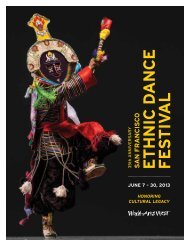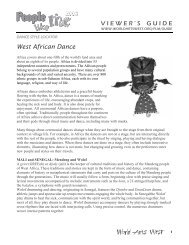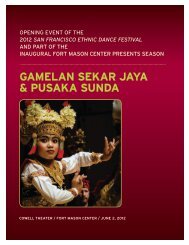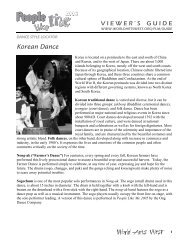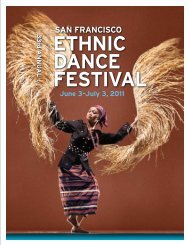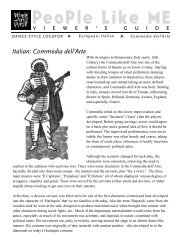South African: Gumboot dance - World Arts West
South African: Gumboot dance - World Arts West
South African: Gumboot dance - World Arts West
You also want an ePaper? Increase the reach of your titles
YUMPU automatically turns print PDFs into web optimized ePapers that Google loves.
V I E W E R ’ S G U I D E<br />
W W W. W O R L D A R T S W E S T. O R G / P L M / G U I D E<br />
DANCE STYLE LOCATOR<br />
(Andean <strong>dance</strong>, continued)<br />
the political message of the nueva cancion was abandoned, and this music then became commercially<br />
acceptable, as it transformed into what we now know as Andean Music.<br />
A recent development in the Andes, as in many areas of the world, is that of “folkloric” music and <strong>dance</strong><br />
groups that perform on stage rather than as part of a religious or secular communal event. Beginning<br />
in 1978, around the time that tourism to the area started to increase, local musicians and <strong>dance</strong>rs began<br />
to perform in tourist restaurants in urban centers, and folkloristic groups in touristic taverns. Latin<br />
American folk music, played live by groups of young middle class Mestizos alternated with recorded<br />
<strong>West</strong>ern disco music.<br />
Suri Siquris is a <strong>dance</strong> that dates back to 800 BC. The name comes from the great headdress made of<br />
feathers from the suri or ñandu (American ostrich) and the <strong>dance</strong> is done in relation to the harvest. The<br />
musicians who play the siqus and <strong>dance</strong> are known as Siquris. The siqus has 17 canes, and comes in<br />
four sizes. They are played in sets of two, in interlocking melody and rhythm. The men dress in beautiful<br />
Alpaca ponchos with color tassels called wichiwichi, and the women dress in beautiful party skirts.<br />
Huayno, also spelled Huaiño or Wayno, is widely recognized as the most representative <strong>dance</strong> of the<br />
Andes, with pre-Columbian (Quechua and Aymara) origins fused with <strong>West</strong>ern influences. While historians<br />
speculate that it may have come from an Inca funeral <strong>dance</strong>, today it is purely festive. A circle of<br />
dancing couples surrounds the musicians, whose instruments may be flutes, drums, harps, and guitars.<br />
Couples dancing the huayno perform sharp turns, hops, and tap-like zapateos to keep time.<br />
Huayno music is played on quena, charango, harp, and violin, however, there are dozens of regional<br />
variations, some of which involve marching bands, trumpets, saxophones and accordions. The musical<br />
structure stems from a pentatonic scale (scale of five notes) with a binary rhythm, (2/4 time). This<br />
structure has made this genre the basis of a series of hybrid rhythms, running from huayno to Andean<br />
rock.<br />
4



